Introduction: That Other Ultralight
Backcountry hunting is a categorically different pursuit than backpacking and its variations. I’ve tried to make this point a stark one with the epigraphical quotation, a forum post from Kifaru rep, Rokslide.com co-founder, and famous internet hunter Aron Snyder. Backcountry hunters obsess about and discuss pack weight just as fervently as backpackers, but as the above figures reveal, the foundational assumptions used by the two camps are very different. In this article I will attempt two tasks: first to describe the conceptual gulf between backpackers and backcountry hunters and how it explains the difference in ultralight pack weights between the two, and second to make an initial foray towards establishing a numerical standard for an ultralight backcountry hunting base weight.
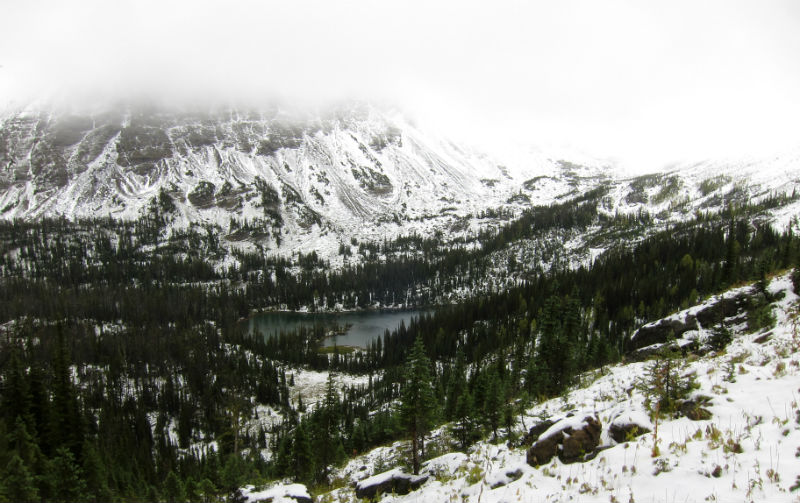
Late September hunting in the Bob Marshall Wilderness. In an ideal hunting situation, animals set the agenda, not the weather, no matter how ugly.
When it comes to the evolution of gear, technique, and mindset, the ultralight standard of less than 10 pounds base pack weight (i.e. everything but consumables) has been around for an eternity. More than long enough for the term to become co-opted for every imaginable marketing angle, for cottage companies and garage tinkerers to push gear well past the ultralight threshold, and for mainstream companies to at last make gear which easily fits into an ultralight gear ensemble. I still don’t put much credence in Ron Moak’s infamous 2012 pronouncement that prior to the early “oughts” an ultralight baseweight required “black arts,” but his larger point from the Ultralight: State of the Revolution series of blog entries is inarguable: advancements in technology have stripped much of the relevance out of the accepted ultralight standard of 10 pounds. It is much easier than it once was, if not just outright easy, to build an ultralight kit and use for just about any trip you might conjure up in (for example) the temperate latitudes of the northern hemisphere between April 1st and November 15th.
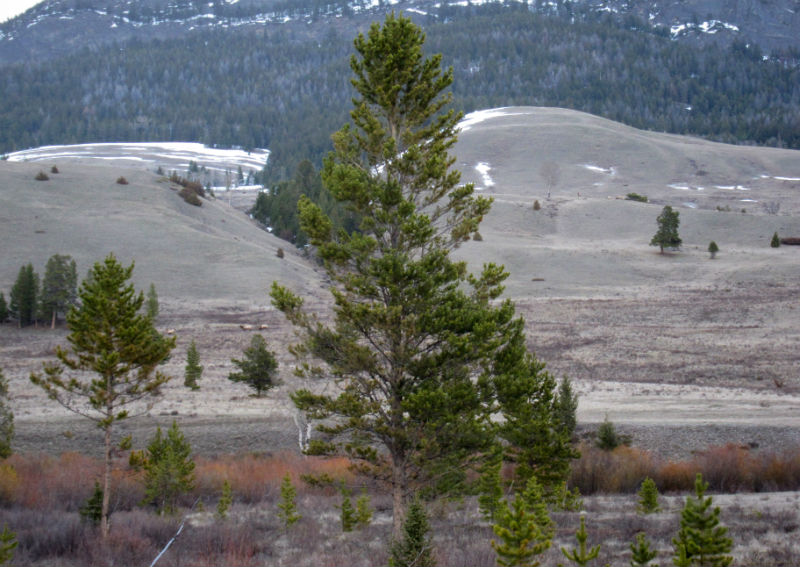
Hunting takes you to places you wouldn’t otherwise go, and shows you things you might not otherwise see, as with these elk let of the big tree in the middle, seen on an April bear hut in the Bob Marshall. 5 minutes after this photo was taken wolves separated an elk from the herd, surrounded it in an aspen thicket, and took it down.
A hard metric for ultralight backpacking baseweight is useful for the same reason it is useful in anything, we humans love to ask for exceptions. Be it a higher baseweight figure for those over a certain height, or an extra SUL pound if you exceed a certain mean elevation, however compelling the excuse, the e-word remains nothing more than an attempt to get away with something rather than embrace the extra challenge of meeting an objective standard. There’s no inherent value in pack of a certain weight, the value can only be found in the trip such a hiker can only now do, as well as the extra consideration and learning meeting a rigorous weight standard can bring about. As Ryan Jordan wrote in 2013, “For me, SUL as a mindset has motivated me not only to be very intentional about what I take on the trail, but also to be very intentional about how I count the costs of all sacrifices that I make with time, finances, material possessions, and relationships.” Establishing a rigorous comparative standard with no wiggle-room helps you learn more. As will be discussed below, when it comes to hunting such things are highly relevant.
Backpacking is the prime mover of overnight ski touring, wilderness packrafting, and to a large extent alpine rock climbing and mountaineering. One does these things to travel through a given landscape in a certain fashion and see what is to be seen along the way. Even climbing is most often dedicated to experience in the landscape more than reaching a summit, witness the profusion of excellent routes which end when the good climbing does. Hunting is different. While pursuing animals in the backcountry is a good way to talk yourself into visiting and looking closely at some obscure, rough, gorgeous country, in the ends it’s like Fight Club. The first three rules of hunting are that to succeed you must kill something. If you spend five days in the mountains you went hunting, and probably succeeded in executing a fantastic backpacking and nature-watching trip, but you did not have a successful hunting trip, however satisfying the overall. I say this not as a value-based statement, but to highlight the principle around which any standard for an ultralight backcountry hunting baseweight must be built. If it will help you kill your prey, it makes the cut, no matter how heavy. As will be seen below, this is a hugely important distinction, because the backpacking pieces of an ultralight hunting pack will be among the lightest items on board.
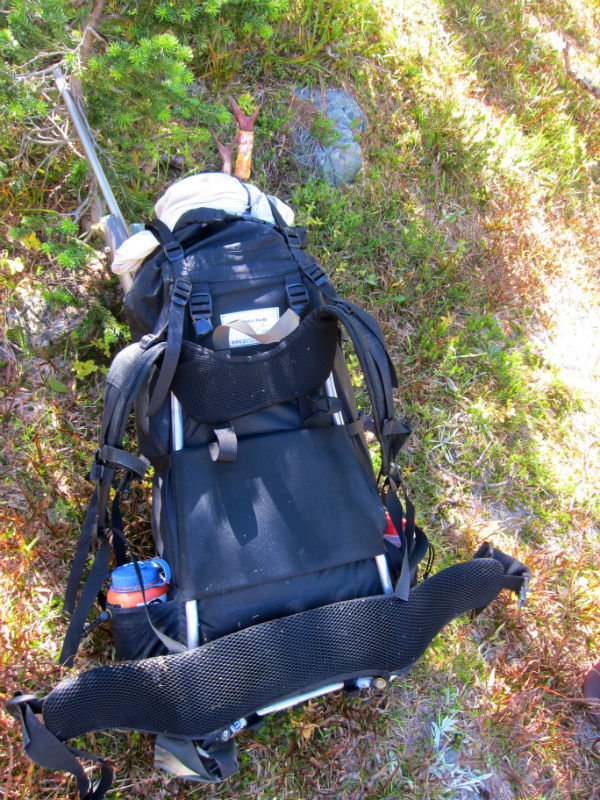
An 80 pound, 8 mile packout in the Bob Marshall. An ultralight hunting kit is still heavy by backpacker standards, and that’s before you add 1500 cubic inches of venison.
Building an Ultralight Hunt
Because hunting has different motivations than backpacking, it often goes into very different places, and does so in different ways. Late September in the Northern Rockies of the United States provides a good example of this distinction. Mixed precipitation is common, as is standing snow in the higher elevations, though daily and nightly lows are usually relatively mild (read: below 20 F is uncommon). A common ultralight backpacking strategy for these conditions is to modify summer gear only a little, perhaps with warmer socks, and if particularly cold and wet conditions are present maintain warm feet via a brisk and steady pace, with perhaps a fire at camp. If the day’s high pass is exceptionally cold, a still stronger pace and an hour of minor suffering is usually all that is required. Hunting the same areas and conditions demands a different approach. Deer, elk, or sheep are likely bedded in invisible locations through the height of the afternoon squall, and descending to find dry wood is likely to spook whatever animals are nearby. Not only does the hunter need to move slowly and quietly through the area to find a high spot with good visibility for when the weather lifts, but he or she must be prepared to stay stationary during and after the storm to glass for and then locate suitable quarry. The ensuing stalk may be fast paced and help warm up cold feet, but might be interrupted at any moment by a forced wait behind a boulder midway across a talus slope, all while exposed to both the wind and the keen eyes of alpine ungulates.
The ultralight backpacker deals with challenging conditions like these with a judiciously selected kit, and adapts to the conditions by varying the pace and manner of travel. The ultralight hunter must adapt to the way the animals respond to ambient conditions, and have the equipment to do so.
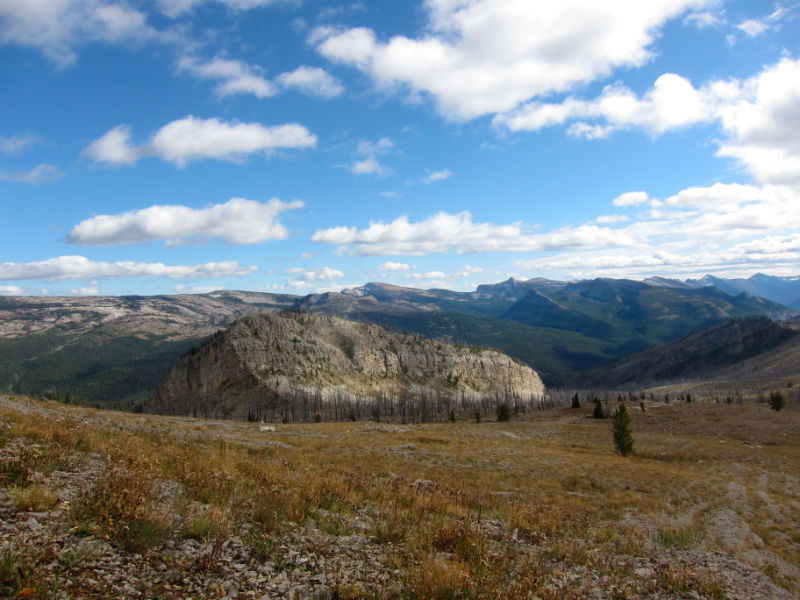
A gorgeous October day in the Bob Marshall Wilderness, five miles from any trail. Sometimes you get lucky with the weather, but to go where the animals are requires worst-case preparation.
All of which is to say that the ultralight hunter will have a much heavier pack, and for good reason. But how much heavier? Ultralight has in hunting, just as in other outdoor pursuits, become a potent marketing buzzword, with whole companies producing products lines devoted to “ultralight hunting.” A baseweight standard should be rigorous enough to push end-users towards defying dogma when choosing their gear. It should also provide consumers with a tool which can help hold gear-makers feet to the fire, and help foster innovation in content rather than marketing.
The following chart is a suggested list tailored to generic autumn conditions; early October in the US Rockies, early September in the Alaska Range, or mid-April in New Zealand’s southern Alps. As can be seen, the weight gets up there in a hurry. The maximum suggested hypotheticals I have here assembled come to a baseweight (worn clothing, food, and fuel not included) right around 36 pounds.
| Category | Item | Example(s) | Example Weight (oz) | Upper limit weight (oz) | Category limit total (lb/oz) |
| Camp | 3+ season shelter for two | Seek Outside BT2, with pole and 10 stakes | 36 | 40 | 4 pounds 9 ounces |
| 20 degree sleeping bag | Zpacks regular/long | 18 | 24 | ||
| sleeping pad | Thermarest Prolite XS | 8 | 10 | ||
| Packing | 80+ pound capable ~4000 cubic inch pack | Paradox Unaweep, Stone Glacier Solo | 52 | 64 | 5 pounds 12 ounces |
| Game bags | 3x medium TAG bags | 10 | 20 | ||
| Drybags for gear, contractor bags for meat | Sea to Summit Ultrasil, Hefty | 8 | 10 | ||
| Cooking | stove and ~1 liter pot | MSR Windpro, Cat can alcohol w/ Evernew pot | 15 | 20 | 2-3 pounds |
| fuel | fuel | 1.5 oz/day/person | |||
| Misc | 100+ lumen headlamp, skinning knife, rope, tags, first aid, repair gear, PLB, hygiene, water bottle etc | Havalon Piranta, Petzl Tikka XP, McMudro Fastfind, satellite phone, etc | 48 | 48 | 3 pounds |
| Clothing (carried) | Durable raingear | Arc’teryx Alpha FL jacket, Rab Xion pants | 21 | 24 | 4 pounds 6 ounces |
| fleece midlayer | Rab Micro pull-on | 8 | 8 | ||
| Insulated jacket | First Lite Uncompahgre | 20 | 20 | ||
| Windshirt | Black Diamond Alpine Start | 7 | 8 | ||
| Light, snug gloves | Black Diamond Mont Blanc | 2 | 2 | ||
| Rain mittens | Outdoor Resarch Revel | 3.5 | 3.5 | ||
| Insulated hat | Original buff | 1.5 | 1.5 | ||
| Spare socks | Smartwool PhD Nordic medium | 2 | 2 | ||
| Clothing (worn) | Midweight pants | Patagonia Simple Guide | 15 | 16 | 6 pounds 10 ounces |
| Baselayer top | Patagonia Merino 1 longsleeve crew | 5 | 7 | ||
| Orange vest | poly mesh construction vest | 3 | 3 | ||
| Boxer briefs | Patagonia silkweight capilene | 2.5 | 4 | ||
| Ball cap | Arc’teryx Neutro visor | 1.5 | 2 | ||
| Socks | Smartwool PhD Nordic medium | 2 | 2 | ||
| Light boots | Zamberland Crosser Mid GTX | 36 | 40 | ||
| Gaiters | Kuiu Yukon | 12 | 14 | ||
| Trekking poles | BD Alpine Carbon Cork | 16 | 20 | ||
| Food | High calorie, palatable foods | Bars, Mountain House, etc | 22/day | 28/day | 28 ounces/day |
| Shooting | .25-.338 caliber centerfire rifle with scope, compound or tradition bow, .45-.50 caliber muzzleloader with scope | Kimber Montana in .308, Leupold 6×36, appropriate rings/bases | 92 | 112 | 8 pounds 8 ounces |
| 12 rounds of ammo, 6-8 arrows | 12x 165 grain Federal Fusion | 10 | 16 | ||
| Scope cover, sling, gunbearer, release, etc | Neoprene scope cover, nylon webbing sling | 4 | 8 | ||
| Optics | 6-10x bioculars with strap or chest rig | 6.5×32 Meopta Meopros with cord harness | 23 | 26 | 8 pounds 4 ounces |
| spotting scope | Vanguard Endeavor HD 65S | 51 | 64 | ||
| tripod/head | Vortex Summit SS | 30 | 32 | ||
| binocular mount for tripod | Outdoorsmans | 2 | 2 | ||
| rangefinder | Vortex Ranger 1000 | 8 | 8 |
This list, and thus I would suggest any ultralight hunting gear standard, must be tailored to account for not only the added weight of weapons, optics, and meat processing equipment, but for a pack which can haul very heavy loads, a shelter which can be pitched in places optimized for game spotting, and clothing which will allow for the aforementioned hanging around and bushwacking in bad weather. Many aspects of the above list will be subject to change depending on location and the species pursued. You’ll need more game bags on a moose hunt than on a deer hunt, for example, and a spotting scope and tripod may not be necessary for hunts in thicker country or for larger, less elusive species like elk and caribou. Later season hunts will demand a warmer sleeping bag and more clothing, while early-fall hunts or hunts in warmer locales might allow for less. Traditional bowhunters will shave pounds off their weapon weight compared to rifle or compound bow hunters. It was my intention however to make this list as close to the median as possible, and to make the individual selections rigorous, but not esoteric. Thus, I propose that the cutoff for ultralight backcountry hunting be a baseweight below 35 pounds (knocking a pound off the total to make for an even figure and account for a certain degree of laziness on my part).
35 pounds: The debate begins
There is, intentionally, a lot to argue about with this list and the 35 pound cutoff for ultralight hunting. I’ll address a few of the point-by-point particulars below.
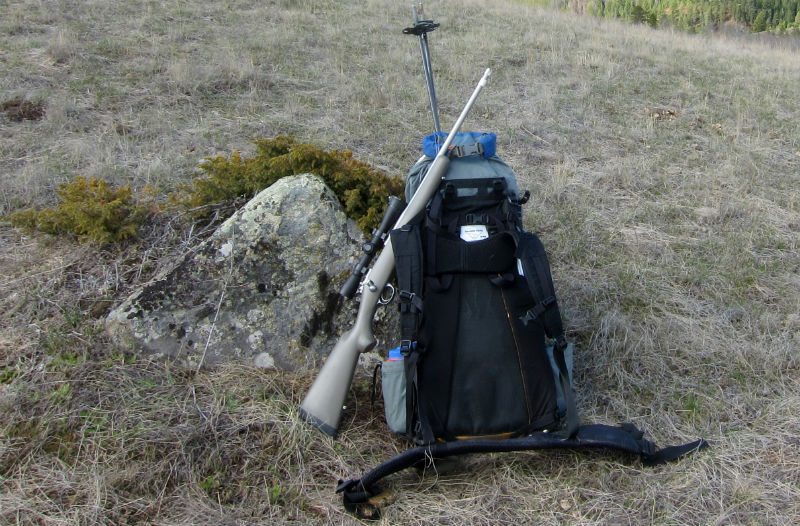
The author’s Kimber Montana. Chambered in the versatile .308 cartridge and with an all-purpose Leupold 4×33 scope mounted, this rifle weighs 6 pounds all up. Weight-saving modifications include cutting the barrel to 20 inches and installing a titanium bolt handle. Weight-adding modifications include a Duracoat paint job, palm swell, and flush swivel cups on the left side.
Having a rifle which comes in below 7 pounds is fairly simple with a non-magnum mountain rifle and a smaller fixed or variable scope. In the US such a combination can be had for little more than $1500. Hunters who cultivate the ability to make shots over 300 yards, and prefer the larger variables and magnum calibers which often go along with such an approach, can still have a sub-7 rifle, but will need to invest a lot more money and be prepared to cope with a hard-kicking gun. Skimping on ammo is also a good way to fail in seeing the big picture. In theory you’ll only need one round, but you never know when you’ll miss once or twice, have to check scope zero after a bad fall, or have to help dissuade a bear from coming in to your camp to check out the meat hanging in a tree. Ultralight will always come with sacrifices, but they should be the right ones.
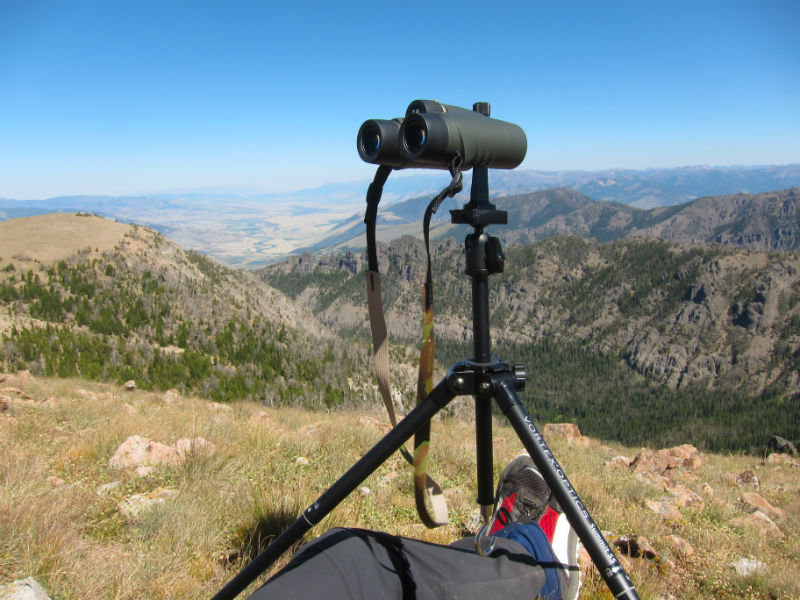
Glassing for bighorns using the Vortex Summit SS tripod and Outdoorsmans binocular adaptor. Binoculars on a tripod are key to attentive all-day glassing.
Some of the questions concerning the necessity of 8+ pounds of optics have been hinted at above, but insofar as hunting can be described as finding the best way to see the deer (or elk, bear, etc.) optics are essential, and skimping here is an almost surefire way to reduce your odds of success. Compact binoculars are a recipe for headaches and eyestrain, and the value of good binoculars mounted on a tripod can almost never be overstated. New England hunters stalking whitetails in softwood swamps may only need binoculars, but most hunters most of the time will find a tripod handy at one point or another. Again, ultralight hunting is all about making wise sacrifices, always keeping the overarching goal of a dead animal in mind.
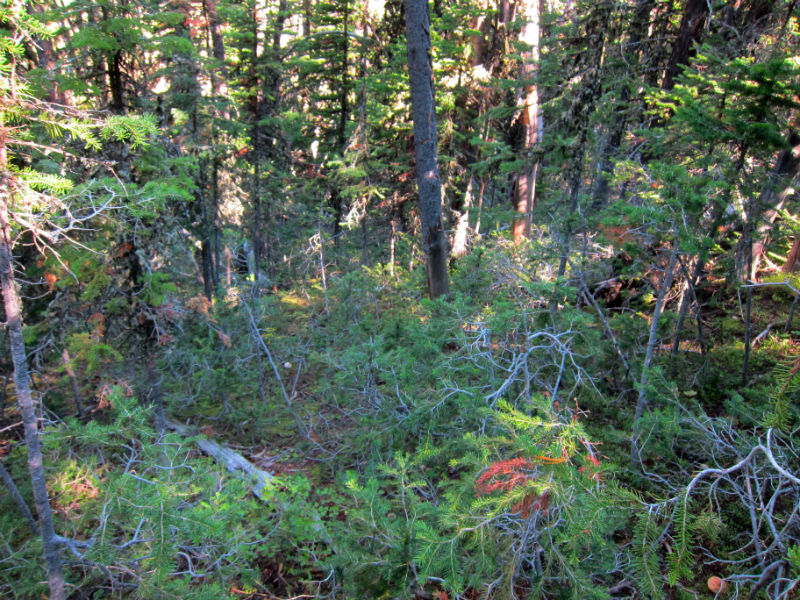
Sub-alpine jungle in the Gallatin Mountains of Montana. When following game sign, you have to go where they go, no matter how steep and thick.
Heavier clothing than the typical ultralight backpacking load is also inevitable for backcountry hunting. Even in big wilderness, the charismatic megavertebrates most hunters pursue tend to treat trails like roads, and try to live their lives that one drainage or basin further from the stream of human traffic, however occasional that stream may be. A big part of the reason hunting the true backcountry has become more popular recently is not because it’s easier. The deer in such places, for example, may well be less wary of humans, but there are also far fewer of them per square mile. Hunting the backcountry, and especially hunting wilderness-dependent species such as sheep, is satisfying because it is as close as hunting gets to being absent from larger human influences. This end will be all the better pursued, and success all the more likely, if you get as far into the thick and nasty and untraveled as is possible. Simply put, this requires clothing which can stand up to such use. 2.5 layer PU raingear and Quantum GL-shelled puffy coats will not get the job done here, at least not for long. The options suggested in the chart are the lightest choice currently available which my experience suggests would hold up to a few seasons of non-pro use (say 20-30 days each year).
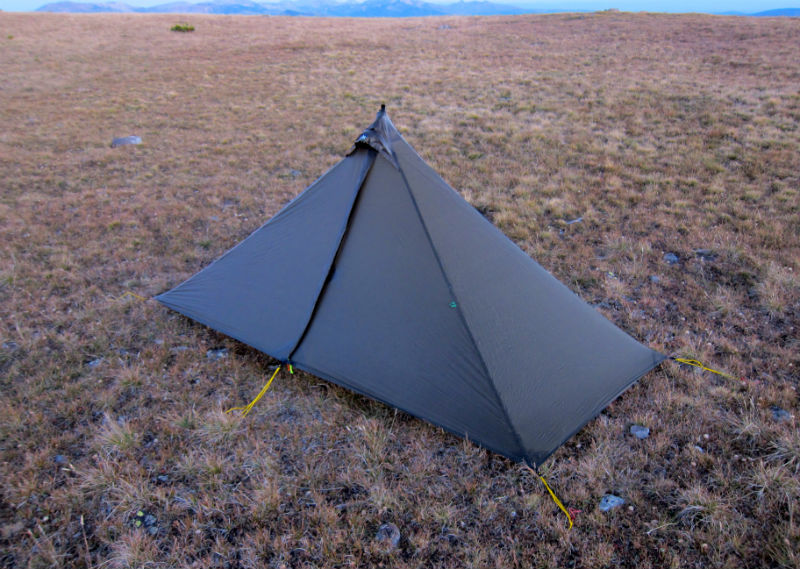
Early season, glassing at first light can be the most productive time of day, which on a backpack hunt means camping as near to a good glassing location as possible. On this sheep hunt, that meant hauling 24 hours of water to a tundra plateau atop a 10,000’ butte, and camping in a very windy spot. A sturdy shelter like this MLD Solomid is recommended.
Footwear is also something where the approach for the ultralight hunter must be very different from the ultralight backpacker. I hardly ever backpack with waterproof footwear, but for fall hunting I’ve found it to be essential. Getting your feet soaked cruising through a snowfield is fine if you can keep rolling at 3.5 mph afterwards. If you need to hunker down to glass instead, dry feet are the only way to have warm feet. Footwear also needs to have enhanced grip and durability for off-trail use, and have enough support and sole stiffness to get that 80 pound load of meat and your camp back to the trailhead. I don’t think the conventional hunting boots, most of which are 2+ pounds a foot and stiff enough to be crampon compatible are necessary or desirable, but something beyond a zero-drop sneaker is probably in order.
Packs for the backcountry hunter must also have different capabilities, while still being as light as possible. Thankfully, hunting packs have undergone tremendous growth in recent years, and there is no longer any need to go above the 4 pound mark in order to obtain a pack which is large enough for an ultralight load and meat, has functional features and compression, and carries weight as well as your legs are capable. A number of makers not mentioned in the chart make solid and well-regarded hunting packs, but the 4 pound barrier is an interesting one because it neatly divides those who have adapted the core design of their suspension systems to be lighter versus those who have merely come out with lighter components for the same old system. The sort of innovation Stone Glacier and Paradox Packs have brought to market in the last two years is the sort of thing which will need to become commonplace if the 35 pound mark is to become as routine for hunters as 10 pounds is for backpackers.

There is little more exciting than the first sighting of a potential quarry through the spotting scope. None of these bighorns proved to be legal rams, but seeing them 2 miles distant on the first night of a hunt made sure the following days were shot through with optimism.
Conclusion: What’s next
Two things are in the future for backcountry hunting. The first is continued gear innovation, increasingly within the hunting industry itself, which will make lighter baseweights ever easier to achieve. Hunting clothing, which as discussed above is both quite heavy and has many demands placed upon it, is one area where it is easy to imagine major improvement. Quite a few hunting-specific clothing companies have come in being, and seemingly done well, since Sitka went into business in 2006. The overwhelming majority of these offerings are still far too heavy, both because of excessive features and the use of heavy fabrics. If the last 15 years of ultralight backpacking has done nothing else, it has proven that functional durability does not need to be sacrificed to obtain lighter gear, often much lighter than anyone initially thinks possible. In the next two years I expect companies like First Lite and Kuiu to knock 3 pounds off the 10+ that is the worn and carried total, with no loss of function or durability. Any backpacker knows that a 40+ pound pack is darn heavy, and no matter how fit you are it will slow you down. On a hunt, slower means less time in good glassing spots, more time needed to close the distance when game is spotted, and more energy expended overall. The harder the hunt, the more I want my pack lighter.
The second is that the backcountry hunting movement will continue to redefine what hunting is and how is it portrayed in the broader culture. Backpack hunting the wilderness shares many skills with front country whitetail hunting, but in many respects the two have as much to do with each other as backpacking does with golf. I don’t think that bow hunting whitetails out of a treestand over a food plot is unethical, especially given the overpopulations problems virtually all of the midwest and south will face so long as whole states remain deer buffets with few natural predators. But the general public is right to see frontcountry, often road-based hunting as something of a peculiar exercise, shot through with contradiction. Backcountry hunting is more of a holistic experience; experiencing where the game lives, humanely killing the animal, carrying the animal back to your home, before finally butchering it and eating it. The whole process fosters an intimacy with the wild which backpacking and its derivations cannot begin to match. In a world increasingly safe and sterile, where the raw math of how we as individuals stay alive is ever more abstract, backcountry hunting is a perfect antidote, and ultralight backpacking and hunting are ideal bedmates.
(Disclaimer: The author has a non-remunerative position as a product tester and design consultant with Seek Outside/Paradox Packs.)




Home › Forums › Ultralight Hunting: Towards a Coherent Definition